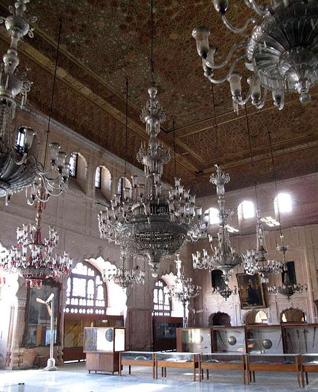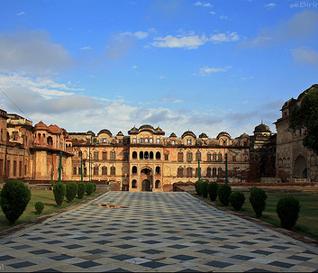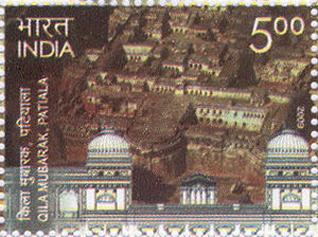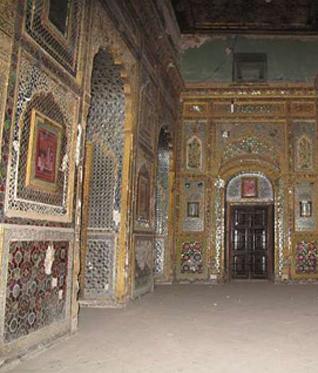Architecture
Qila Mubarak: A Tale of Neglect & Abuse
by JAIDEEP SARIN
Its name means the 'fort of triumph', and it's a symbol of the history and culture of the Sikhs. Qila Mubarak has withstood many attacks in its over 200-year history but is today fighting a losing battle - against government apathy.
A peek into the interiors of Qila Mubarak, Patiala's royal fort, by a television documentary series has highlighted how the fort is being neglected. Instead of letting in only the admiring tourist, the complex houses several government offices, including a forensic laboratory.
'The fort is in danger because of the state government's apathy. We are going to lose it soon. It is not only ironical but tragic that the state government is blind to the imperilled Patiala fort that was once the pride of entire Punjab,' leading theatre personality Gurcharan Singh Chani, who has prepared a documentary series on the leading forts in India for Doordarshan with his son Gyandev, said.
The foundation of the fort was laid by founder of the Patiala dynasty, Ala Singh, in 1763. It was completed by his grandson and successor Maharaja Amar Singh, but historians differ over the exact year.
The Patiala chiefs, who opposed Mughaluslim rule as guerrilla fighters, founded a state in the 1760s. Ahmad Shah Abdali, the Afghan ruler after Nadir Shah, conferred the title Raja on Ala Singh.
Built on level ground, which now stands in a crowded area right in the middle of Patiala town, 80 km from Chandigarh, the capital of Punjab, the fort is classified as a 'Nara Durg' - a citadel defended primarily by brave soldiers because it is not protected by any natural armour like mountains, forest or water body.
Ala Singh wanted a sophisticated fort on the plains, one that was strong enough to repulse a fierce Maratha attack in 1794.
Initially built as a mud-fort, Qila Mubarak was later built with bricks. The fort housed the palace of the royal family of Patiala at one stage.
The rulers of Patiala had reached an understanding with the British in the 18th and 19th centuries to keep Maharaja Ranjit Singh at bay.
However, today, the fort complex houses offices of 10 government departments, a testimony to the shocking neglect by the authorities.
Even the state forensic sciences department has its office and laboratory, where chemicals are used freely to conduct tests on human organs as part of criminal investigations, inside the Qila Mubarak complex.
'Ranvas (a portion of the fort complex), which has beautiful paintings, is being used as state forensic laboratory,' Kavita Singh, an art historian from Jawaharlal Nehru University (JNU), says in the documentary.
'The first time I went to Patiala, a number of government offices were functioning over there. Here was a beautiful structure filled with amazing paintings, architecturally very interesting and doubly significant because it is in Punjab unlike Rajasthan, where there are so many forts which have good architectural qualities.
'I remember going there and seeing a wall where there were beautiful, delicate paintings ... and a nail is driven right through the painting and a calendar hung on that nail,' she recalls.
The buildings inside the fort reflect a blend of Rajasthani, Pahari and Mughal cultures.
'The style of Patiala is greatly influenced by Rajasthan. A number of arts and crafts bear the imprint of Rajasthan. It was the painters of Alwar and some from Jaipur who came to work here in Patiala,' noted art historian B.N. Goswani said.
'Sheesh Mahal is a beautiful hall in the Qila Andaroon palace in the fort, in the image of Mughal style. The rulers here were particularly fond of walls decorated with small and large mirrors. Hundreds of reflections on an individual created a bewildering effect. A single source of light could dazzlingly light up the area to make it look like Diwali,' he added.
The main gate of the fort is all but lost in the hustle and bustle of the crowded and popular Adalat Bazaar.
'The beautiful carvings on stone are invisible. One cannot even notice the small towers and windows with petite balconies jutting out. It is a matter of great regret that such a beautiful fort has suffered from neglect and stands crumbling in a shamefully ruined state,' Gurcharan Singh Chani said.
[Courtesy: Sify. Edited for sikhchic.com
May 27, 2011
Conversation about this article
1: H.S. Vachoa (U.S.A.), May 27, 2011, 4:50 PM.
True nature of Hindu governance.
2: Isher Singh (Bangalore, India), May 28, 2011, 6:01 AM.
Let's not blame others. It's the apathy of the Sikhs themselves who do want to care for their historical relics. Let's us not hide our weakness. We have seen murals in many a gurdwara being white-washed or marbled over in the name of Kar Seva. It's our history and it's OUR responsibility to look after them.
3: Dr.Birinder Singh Ahluwalia (Toronto, Ontario, Canada), May 28, 2011, 8:01 AM.
The last time I checked, Patiala is in Punjab state and currently this state is being governed by a party that goes by the name "Akali Govt." which in some tangential manner suggests a government by the Sikhs, of the Sikhs and for the Sikhs. I suggest all of us should avail this wonderful opportunity whereby we motivate the Akali government in Punjab to take approrpriate action to restore all Sikh heritage sites (including Qila Mubarak) to it's original glory for the present and coming generations to enjoy the richness of Sikh/ Punjabi history. I am certain there are a few out there in this world who can approach this stupendous government in Punjab and I am certain they will pay heed to such an important matter. I was encouraged to read somewhere that many politicians in the Akali government are university educated (some from abroad). I guess this will make the task much easier for whoever will converse with intelligent, adult, educated politicians in the Akali government re this important issue which effects not only Sikhs and Punjabis but all those who wish to enjoy the glorious history of Punjab and India.
4: Kirpal Singh (Daytona Beach, Florida, U.S.A.), May 28, 2011, 9:52 AM.
I agree with Sardar Isher Singh of Banglore. Protection and maintanence of Sikh heritage is the responsibility of the Sikhs themselves, no matter how they get it done. Look at the incomplete Khalsa Heritage Project in Anandpur! The government will not do such tasks unless there is pressure put on them, and they see political benefit from them. Just look at SGPC - the so-called Sikh religious body but unable to attend to Sikhi issues even among the Sikhs in Punjab and India! Why blame others?
5: H.S. Vachoa (U.S.A.), May 28, 2011, 1:34 PM.
True, but how are the Akalis a Sikh party?
6: R. Singh (Canada), May 28, 2011, 7:04 PM.
Akalis are the extension of the Saffron hindutava posse! Just fantasizing that Sikhs have a 'party' is like believing "Alice in Wonderland" to be a reality.
7: Gurjender Singh (Maryland, U.S.A.), May 28, 2011, 8:08 PM.
I agree with Isher Singh ji. The Gurdwara managements can waste millions of dollars to decorate marble walls with gold. The sangat's money could be far better spent to protect our history and heritage ... and to do a dozen other important things.
8: H.S. Vachoa (U.S.A.), May 29, 2011, 1:54 AM.
The modern-day politiciand who call themselves 'Akalis' have never stood for Sikh interests. Protection and maintenence of Sikh heritage is the responsibility of Sikhs but these Akalis are the last ones to look for it.
9: Baldev Singh (United Kingdom), May 29, 2011, 7:39 PM.
As someone lucky enough to visit Amritsar and Patiala on a regular basis from the UK, this scandal is not just apathy but a systemic failure of education of the masses with a pride to be 'clean, decent, caring humans'. What we have in South Asia is a completely selfish, cynical approach to life and living, where it is a 'religion' to neglect everything, including new-born females and poor and ill people, so how are buildings or any heritage going to be important when all that matters is acquisition of MONEY.






